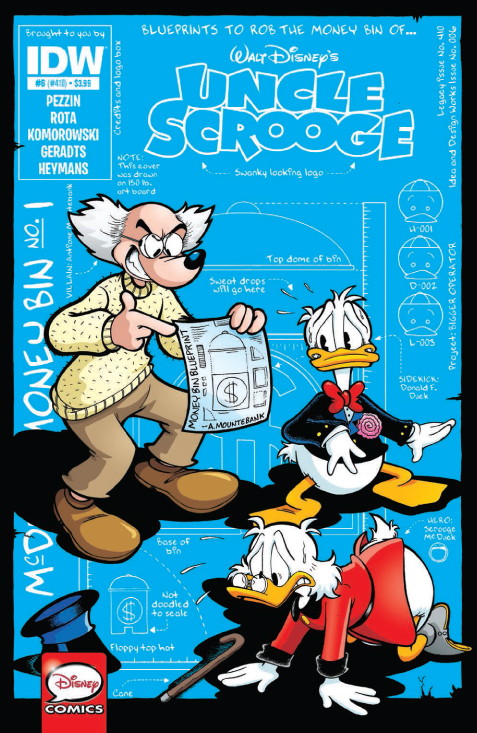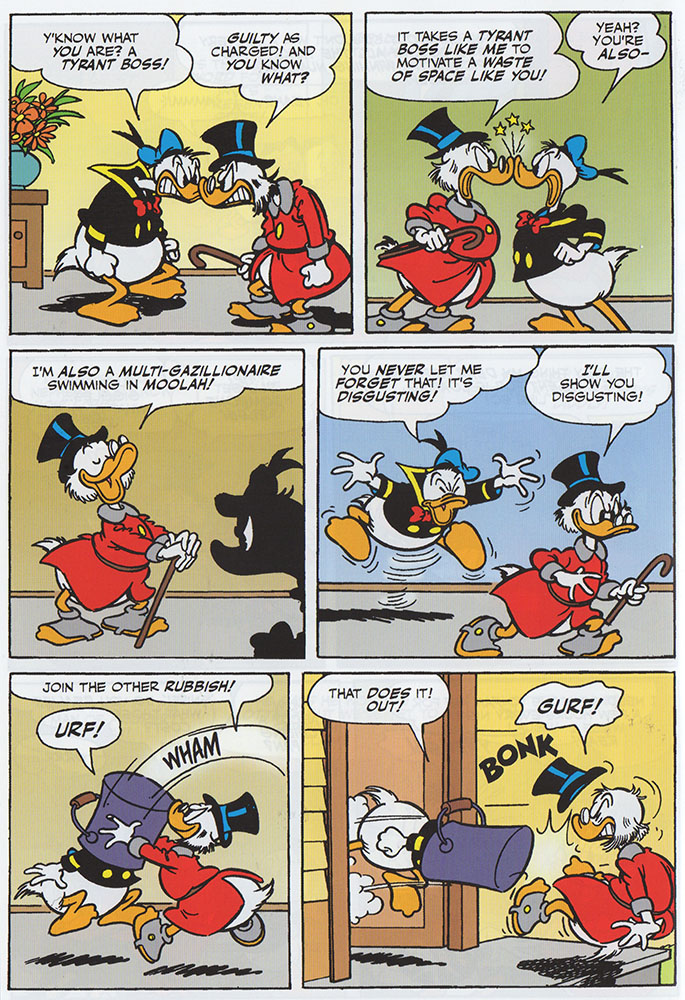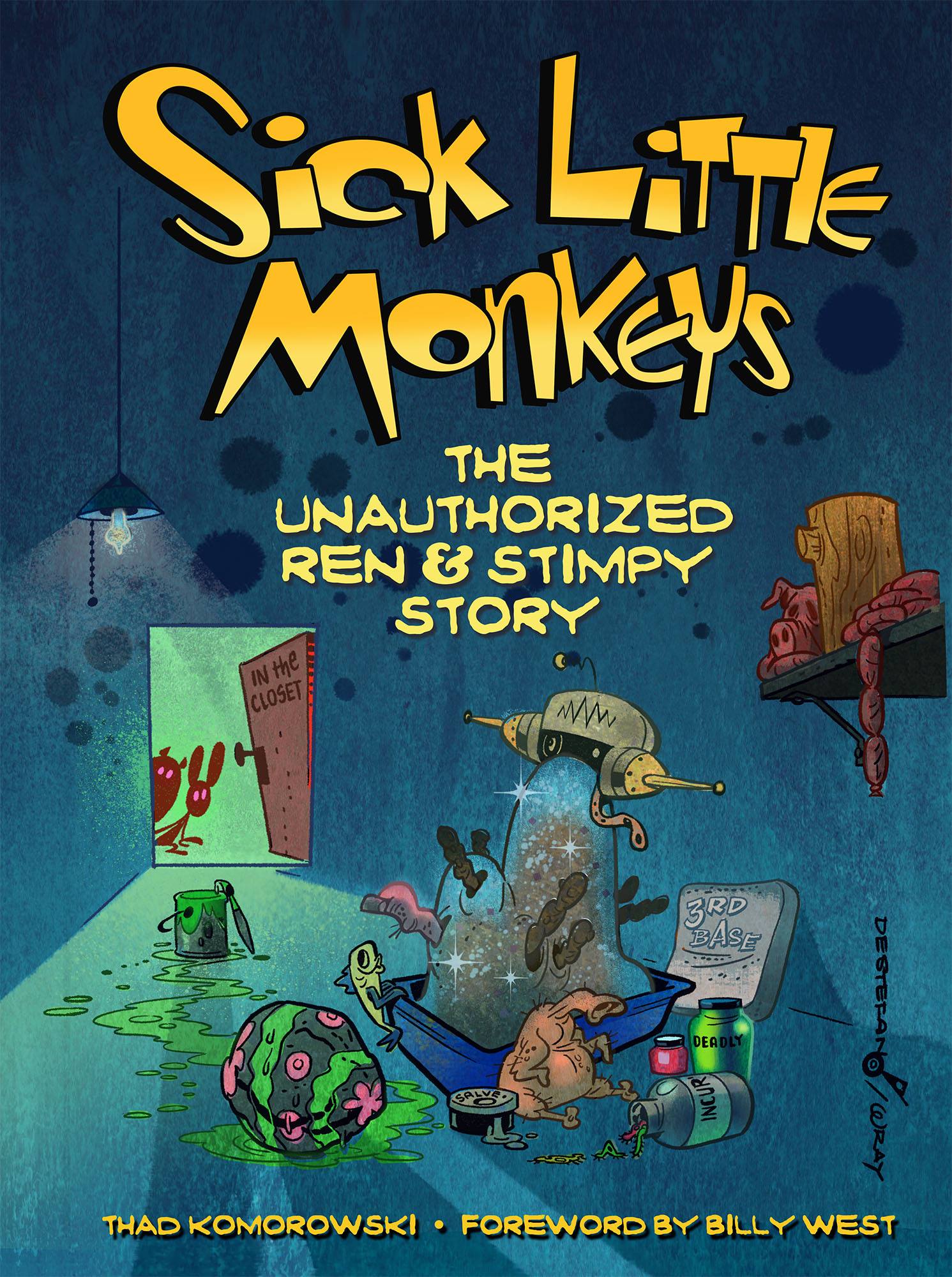 As much as I decry nostalgia, I’ve got the bug: going to the comic shop regularly again to buy Disney comic books takes me back. But who could have foreseen that my name would actually be on the covers? Especially covers already boasting Walt Disney’s? To the left is last month’s Uncle Scrooge #410, in which I scripted the American dialogue for “The Bigger Operator,” a 1974 story written by Giorgio Pezzin and drawn by Marco Rota. The great blueprint cover was drawn by Jonathan Gray.
As much as I decry nostalgia, I’ve got the bug: going to the comic shop regularly again to buy Disney comic books takes me back. But who could have foreseen that my name would actually be on the covers? Especially covers already boasting Walt Disney’s? To the left is last month’s Uncle Scrooge #410, in which I scripted the American dialogue for “The Bigger Operator,” a 1974 story written by Giorgio Pezzin and drawn by Marco Rota. The great blueprint cover was drawn by Jonathan Gray.
Archival editor David Gerstein’s staff of writers, artists, and designers is his dream A-Team (of which I’m proud to be a part of), and he’s stuffing just about every issue with prime material. It’s easily the most satisfying Disney line since the original Gladstone run of 1986-90. Most refreshing is that publisher IDW has gone back to a format that encourages impulse buys, with 40-page monthlies at $3.99 (although my mother was aghast comic books were priced as high as that). I’ve always maintained the 64-page “prestige” format that Bruce Hamilton spearheaded during the second run at Gladstone in the ‘90s, and continued at Gemstone in the ‘00s, was a mistake that cost the Disney comics their general readership here in America. It’s probable passerby would see a $3.99 monthly comic-book with Donald, Scrooge, or Mickey and say, “Hey, I love these guys! I want it!” Upwards of $8? Forget it.
That’s not to say things are perfect now, though. There’s thousands of pages of great Disney comics that have never seen publication in America, and I applaud the emphasis of printing Romano Scarpa’s unseen classics. But we’ve got some pretty talented living cartoonists and writers right here in the states who’d love to take a crack at these characters, so it’s a crying shame the budget won’t allow the production of brand-new material.
The flagship anthology Walt Disney’s Comics and Stories probably isn’t the place for the yearlong “Zodiac Stone” serial either, especially since it will take up the near entirety of every issue for twelve months (its total length is over 300 pages). And I certainly can’t get behind fulfilling reader requests for reprints of the fatally bland Mickey Mouse comics drawn by Bill Wright and Paul Murry. But, if every issue was full of “excellent” material, it’d run out fast. (Another flaw of the 64-page format is if you need to fill that many pages every month, the well will surely dry.) If there is a loyal audience for Wright, Murry, or even (shudder) Tony Strobl, why deprive them? And there’s certainly no reason to decry “Zodiac Stone,” a fine story Jonathan Gray has wanted to bring stateside for some time, finally seeing American publication, even if the presentation isn’t ideal.
If you had to subscribe to just one title, I’d probably choose Donald Duck, for its consistent inconsistency of the main character. In one issue, he’s the quintessential Barksian career bungler working for Uncle Scrooge’s brother’s newspaper. In another, he could be paired with cousin Fethry in an odd-couple secret agent adventure. The beauty of the comic-book Donald, compared to the one-dimensional animated duck, is the casting range: regardless of setting and motivation, there remains no question he is the same character at his core.
 The most intriguing story so far has been “The Diabolical Duck Avenger,” the 1969 origin of Donald’s caped crusader alter ego that appeared in Donald Duck #372 and #373. The utterly adolescent Donald here, obsessed with outwitting Scrooge and cousin Gladstone Gander by any unsavory means, recalls not Barks or any other Disney creator, but John Stanley and his male antiheroes, Tubby Tompkins (Little Lulu’s bosom chum) in particular. For pages, there’s strictly non-expositional and aggressive business, the most Stanley-like of which I’ve illustrated here. As in Stanley’s longer-form stories, Guido Martina (the story’s Italian writer) seems to just be filling panels and biding time until the real action starts.
The most intriguing story so far has been “The Diabolical Duck Avenger,” the 1969 origin of Donald’s caped crusader alter ego that appeared in Donald Duck #372 and #373. The utterly adolescent Donald here, obsessed with outwitting Scrooge and cousin Gladstone Gander by any unsavory means, recalls not Barks or any other Disney creator, but John Stanley and his male antiheroes, Tubby Tompkins (Little Lulu’s bosom chum) in particular. For pages, there’s strictly non-expositional and aggressive business, the most Stanley-like of which I’ve illustrated here. As in Stanley’s longer-form stories, Guido Martina (the story’s Italian writer) seems to just be filling panels and biding time until the real action starts.
It’s a gamble for sure. Stanley is nowhere near as universally loved as Barks, as he took bigger risks portraying humanity’s nasty side and eschewed the warm sincerity that pervades all but a scant few of Barks’s stories. Martina penned dozens of stories in this mold, and Gary Leach, the American translator of “The Diabolical Duck Avenger”, perfectly preserved it. For the right reader, it’s a gamble in characterization that paid off handsomely.
Whereas there’s no gamble buying any of these comics. If you haven’t caught up with them, do so, in hopes that David and his pals can keep it up.
(For the record: I speak only for myself as a comics historian, scholar, and geek, not as a representative of IDW or Disney.)


Interesting stuff, Thad. …Some points in order:
Like you, I still find it hard to believe that my name is on the cover of these books, even after all this time. And, also like you, I’m extremely proud to be a part of this team! It IS truly a “Dream Team”!
I’m completely in agreement that a “standard format” is better for business than pricy prestige. Particularly now, in this age of good paper stock. Even for ordinary issues. These comics “look special”, without the overpriced format.
Every Disney comic book line, from Dell to IDW, has had its plusses and minuses, but I feel that IDW may be the best Disney comic book run of the modern era. By that I mean Post-Western. Sure, nothing can top the sheer excitement of Gladstone Series One, with primo reprints (when such things were still rare), new star creator discoveries, creator credits and letter columns for the first time. You got the feeling that they really cared!
But the reprints eventually became commonplace, with more repetition than could possibly be imagined in the early to mid-eighties. The paper was ordinary (though standard for the time), and is now turning a “different color”. The printing wasn’t particularly good. And, Geoffrey Blum aside, the translated stories just didn’t read as well as they do now. That’s not just me talking. Fellow Blogger and longtime fan Ryan Wynns recently told me that the IDW comics “read better” than their modern-era predecessors. So, we should all take a bow for that.
I guess I shouldn’t even try to mount a defense of Murry, Strobl, and Wright. Like Hanna-Barbera cartoons (the “good ones”, not the ’70s and ’80s crap), it’s very likely a matter of when I grew up. I *am* glad Murry, Strobl, and Wright are part of the mix, as long as “reprints-I-already-have” never dominate.
My not being a fan of John Stanley may very well explain why I don’t care for “The Diabolical Duck Avenger”. Though, to be completely fair, I have not yet read Part Two. Perhaps it rallies and gets better. I’ll get it tonight, when I go for MICKEY MOUSE # 6.
If the argument scene you illustrate is typical of John Stanley’s work, that might also explain *why* I was never a big fan of his. Though, as with other things like POGO, I’m probably the one who’s out of step. It is mean-spirited, but without being funny. Fred Flintstone can be mean-spirited to Barney Rubble in the early episodes of The Flintstones – but it is also funny. That’s what’s missing here – the Funny! And maybe that’s what’s missing from Part One of “The Diabolical Duck Avenger”.
True, the Donald Duck title has had the most varied stories, presenting Donald in a wide range of roles. So it’s probably the best title to start people on. I’ve personally enjoyed the Uncle Scrooge title the most so far–but that’s partly because I like some of the ancillary characters who show up in U$ stories, such as Belle Duck and especially Magica (loved her dialogue in “Of Mice and Magic”, Thad!). In WDC, I’m OK with the 12-issue Zodiac Stone, especially since the stories work well enough as standalones. They won’t be as frustrating to the reader who picks up just one issue as the old three-part Mickey stories were back in the day.
In terms of overall choice of stories, I’m pleased with the mix so far, but looking forward to the time when IDW Disney will be able to start printing stories that originated with Egmont. Most of the dozens of stories I’ve read in other languages which I’d like to see in English are Egmont stories.
And yes, it would indeed be great if we could get new American stories written and drawn by American creators. Maybe at some point that can happen, at least on an occasional basis. Meanwhile, the closest we can come to that is publishing stories written for Egmont by American creators (Sarah Kinney, Stefan Petrucha, Mark and Laura Shaw, Noel Van Horn, etc. )–who probably *would* have created new stuff for an American publisher if the economics of comics publishing had made that possible!
I’m a big John Stanley fan, too, but I’d like to point out to Joe that Stanley, like Barks, was good at writing several different sorts of humor. I realize you were comparing Martina to only one side of Stanley’s work. My own favorite Stanley stories (even in childhood) are the stories where Lulu is the storyteller, including the Witch Hazel stories. Partly I liked the stories for the fantasy elements, and the all-female cast of some of them. But I also enjoyed and still enjoy the sophisticated humor where the text in the narration box would be at odds with the content of the panel it’s purportedly describing. So Joe, don’t think Stanley is *all* non-expositional, aggressive business! (Not that that’s bad, you understand, just not my favorite.)
Elaine, that is true re: Stanley’s versatility. I agree 100%. The Woody Woodpecker stories in New Funnies and the Tubby-centric Lulu stories are indeed my favorites, though, and non-expositional, aggressive, self-centered business are their stock-in-trade!
I’m going to write a longer comment later but for now I’m curious… how much more money is needed to produce original American material? And is there anything we can do as fans to let IDW/Disney know that we WANT original material. Maybe IDW/Disney could use crowd funding as a temporary measure until producing original material is profitable. Just an idea, I’d like to hear your perspective Thad.
Clapton,
As I said, I can’t (and won’t) speak for IDW at all. But based on my knowledge of industry rates, the production of original material would be significantly more than reprints, and it wouldn’t be in any company’s best interest to crowdfund the production of stories it couldn’t own. If the Disney comic sales continue to be good (and they’re very good indeed), who knows, maybe new stories will be produced!
I just realized that IDW has just begun publishing stories that originated with Egmont: “Truth or Consequences” in DD and “The Duck Who Came to Dinner” in WDC, for starters. So I should have said, I’m looking forward to *more* Egmont-produced stories to come! No doubt some of those will be created by folks from the USA, along with European greats. I want both Marco Rota and Mark & Laura Shaw, myself.
I am overall very happy with IDW’s Disney comics, but like Elaine, I too wish there were more Egmont stories that were published.
Thad, can you, Joe, or someone else who is involved with IDW Disney comics tell us why few Egmont stories are being published. Is there some problem with IDW getting Egmont stories, or is it a choice that the people at IDW are making? Of course if you can’t tell us or if you don’t know the answer I totally understand.
While I do enjoy the Italian stories, it does seem odd that so few Egmont stories, which were the “bread and butter” of European stories from Gladstone to Gemstone, have been published so far. I don’t understand why the new-to-North America William Van Horn stories have not been published for example.
Any light you could spread on this would be greatly appreciated. Thanks!
Dean,
It’s rare when any licensee does books “perfect” right out the gate. Gemstone took about two years to get it “right,” and one could argue the second run of Gladstone and Boom never got it right. But rest assured, we’ll see more Egmont stories in future IDW issues.
Thad,
Thanks for the quick reply! I am glad that more Egmont stories are coming up. Not that I want the great Scarpa and other Italian stories to stop — just a little better balance.
Totally agree that other than Casty Mickey stories and the last few months, Boom *never* got things right. :( I am so glad IDW has the license now.! :)